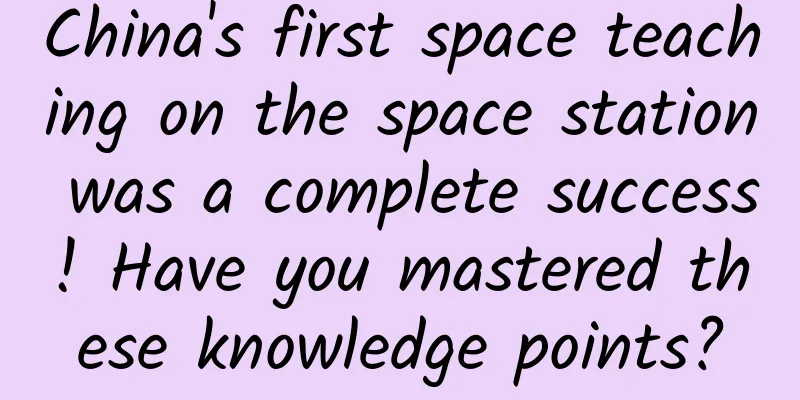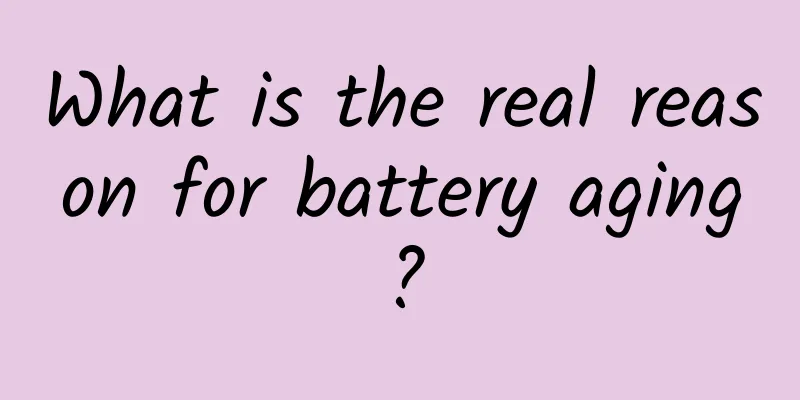China's first space teaching on the space station was a complete success! Have you mastered these knowledge points?

|
According to the China Manned Space Engineering Office, the first class of the "Tiangong Classroom" officially started at 15:40 Beijing time on December 9, 2021. After an interval of 8 years, Chinese astronauts once again gave lectures in space. "Space teachers" Zhai Zhigang, Wang Yaping, and Ye Guangfu brought a wonderful space science class to young people at the Chinese space station. This was the first space teaching activity at the Chinese space station. In the 60-minute lecture, astronauts Zhai Zhigang, Wang Yaping and Ye Guangfu from the Shenzhou 13 flight crew vividly introduced and displayed the work and life scenes of the space station, demonstrated cytology experiments, human body movements, liquid surface tension and other magical phenomena in a microgravity environment, and explained the scientific principles behind the experiments. During the lecture, the astronauts interacted with teachers and students on the ground in real time through video calls. The space teaching activity was broadcast live throughout the entire process. The main ground classroom was set up in the China Science and Technology Museum, and four ground branch classrooms were set up in Nanning, Guangxi, Wenchuan, Sichuan, Hong Kong and Macau. A total of 1,420 primary and secondary school student representatives participated in the live event. The teaching activity is jointly sponsored by the China Manned Space Engineering Office, the Ministry of Education, the Ministry of Science and Technology, the China Association for Science and Technology, and China Central Radio and Television, and supported by the China Science and Technology Museum and relevant research and testing units of the manned space engineering. In the future, the "Tiangong Classroom" will continue to carry out space teaching activities, actively spread manned space knowledge and culture, and continue to carry out aerospace science education in various forms and with rich content. Highlight the key points! These are the knowledge points behind space teaching! The three astronauts of the Shenzhou 13 crew, Zhai Zhigang, Wang Yaping and Ye Guangfu, demonstrated cytological experiments, object movement, liquid surface tension and other phenomena in a weightless environment, and conducted a total of 8 space teaching projects. Why did the Tiangong Classroom choose these projects as the teaching content for its first course? What knowledge points are contained behind each experiment? Let's take a look... Space Turn Knowledge point: Angular momentum In the space lecture on the 9th, the three astronauts first demonstrated the magical phenomenon of turning around in space. This ordinary action, which originally had zero difficulty coefficient on the ground, hides a high level of physics knowledge in space. Ye Guangfu demonstrates turning in space Chen Zheng, deputy head of the China Science and Technology Museum's popular science lecturer group, said that the key word in the space turning experiment is angular momentum. Angular momentum is a physical quantity that describes the rotation of an object. This experiment shows that in a microgravity environment, astronauts, without touching the space station, can verify that "without external torque, the object will be in angular momentum conservation" in an ideal state. When the astronaut's upper body turns to the left, according to the principle of angular momentum conservation, the lower body will turn to the right. Another action is when the astronaut stretches the body, because the mass is distributed far from the rotation axis, the rotational inertia is large, so the angular velocity slows down, which means the rotation is slow. When the limbs are retracted, the rotational inertia is small, the angular velocity increases, and the intuitive feeling is that the rotation speed becomes faster. Buoyancy loss experiment Knowledge point: Buoyancy and gravity go hand in hand In many science fiction movies, there have been scenes like this: once gravity disappears, buoyancy also disappears, and people find it more difficult to swim. The buoyancy disappearance experiment conducted by space teacher Wang Yaping shows this phenomenon. Wang Yaping and Ye Guangfu demonstrated the water film tension experiment (This little flower was made by Wang Yaping and her daughter) Chen Zheng told reporters that this experiment shows the phenomenon of buoyancy and gravity coexisting. Buoyancy comes from the pressure difference of liquid at different depths caused by gravity. When gravity disappears, the pressure inside the liquid is the same, and buoyancy disappears. However, it is difficult to make buoyancy disappear on the surface of the earth, so this experiment is difficult to show intuitively. Under the microgravity conditions of the space station, the coexistence relationship between buoyancy and gravity can be very clearly shown. Wang Yaping and Ye Guangfu demonstrated the buoyancy disappearance experiment Water ball optical experiment Knowledge point: Principle of convex lens imaging The space water ball optical experiment demonstrated by astronaut Ye Guangfu simultaneously demonstrated three physical principles. Chen Zheng introduced that when an astronaut puts a bubble into the water ball, because the buoyancy has disappeared in space, the bubble will not float upwards, but stay in the water ball. The water ball is thus divided into two parts by the bubble, with air in the middle and water around the bubble. At this time, the entire water ball becomes two lenses, the outer circle becomes a convex lens, so an inverted image is presented, and the inner circle is equivalent to a combination of two concave lenses, and an upright image appears at this time. Therefore, two images, one upright and one inverted, can be seen in the water ball at the same time. This experiment actually reflects three physical phenomena. First, in a weightless environment, water droplets will shrink into a nearly perfect sphere under the action of surface tension. On the ground, due to the influence of gravity, water droplets appear in the shape of a water drop, and it is almost impossible to obtain a perfect water ball. Secondly, this water ball can be regarded as a convex lens. If you stand at twice the focal length of this convex lens, you will see an inverted real image. Finally, a bubble is put into the water ball. Because the buoyancy disappears in space, the bubble will not float out and it will stay inside honestly. This experiment can actually be simulated on the ground through glass, but the effect will definitely not be as good as that presented by a water ball. Effervescent tablet experiment Knowledge point: Microgravity environment The effervescent tablet experiment conducted by the astronauts is an interesting experiment in this space lecture. Chen Zheng introduced that in the ground environment, if you throw an effervescent tablet into a water ball, you can see the bubbles floating up. However, in the weightless environment of the Chinese space station, due to the disappearance of buoyancy, the bubbles produced by the effervescent tablet thrown into the water no longer float up, but squeeze each other, and finally form a very interesting shape. The water ball will also be expanded by the bubbles, and you can see the effect of the water ball expanding little by little. Wang Yaping puts the effervescent tablet into the blue water ball Because the biggest difference between the space station and the ground is that the space station is a microgravity environment, but the microgravity environment is just a noun for ordinary people. Through these experiments, everyone can know that in a microgravity environment, many physical phenomena are different from those in the ground environment. Chen Zheng said that the reason why these physical experiments were chosen for this space course was based on many considerations. First of all, from the perspective of safety, the experiments conducted in the space course must be carried out under the condition of ensuring the normal operation of the Chinese space station, because the Chinese space station is a brand new space station and astronauts have a lot of work to do. Therefore, the experiments in the space course must first ensure safety, which is the overriding principle. Secondly, from a teaching perspective, there are obvious differences between the sky and the underground, so we need to select some experimental projects that can show the obvious differences between heaven and earth, so that everyone can intuitively feel the difference between the space environment of the space station and the ground environment. Finally, we hope that the content and process of space teaching experiments will not place too much burden on astronauts. Astronauts are very busy and have a heavy workload in the space station, the content and operation of space teaching should not be too complicated, but should be as simple as possible, and can show results quickly, not take too long, and not increase the work pressure of astronauts. Source: Science Popularization China compiled from Xinhua News Agency, CCTV News, Guangming Online, Global Times, Qilu Evening News, Sichuan Daily, etc. Video from: CCTV News |
>>: Purple dye, an accident, opened an era
Recommend
Hua Chunying tweeted: China has provided more than 2.4 billion masks to the United States. Let's see how many masks each American can get!
Original title: Hua Chunying tweeted: China has p...
A brief analysis of the three elements of copywriting: background, conflict, and answer
It’s always good to know some copywriting skills....
Raising 500,000 babies for others and then having to return them, what is this doing?
Biologist Celia Leto dives to the bottom of the o...
One-third of children do not get enough sleep. How much sleep do children need in a day?
Just as electronic devices need to be charged, sl...
GSMA: China's 5G vertical industry application cases in 2022
2021 is a critical year for 5G to achieve initial...
Thrilling and exciting! Looking back at the first human journey to the moon | Human Lunar Day
54 years ago today, Armstrong left clear footprin...
20 free resources to learn Android development
Today, Android has become the most popular mobile...
1263.5 cubic meters per second! The largest hydropower station under construction in the upper reaches of the Jinsha River successfully cuts off the flow
On the 11th, the State Energy Group announced tha...
Wenzhou SEO Training: What is the impact of website title modification on keyword optimization ranking?
With the continuous development of SEO promotion ...
How can community operations be converted from 0 to thousands of users?
Why is no one joining my community? Why can't...
How to use growth hacking thinking for promotion?
Back to August 1, 2017, at 11:23 am, I was still ...
WeChat 3.0.0 Mac official version released: finally open Moments
[[390583]] After more than half a month of intern...
The 2022 Hunan Province Practicing Veterinary Qualification Examination Fee Standards have been released: How much is the fee per person per subject?
The practicing veterinary qualification examinati...
A gaming version of Chromecast? What kind of gaming console is the Magic Wand?
There are many types of TV game consoles, and all...









